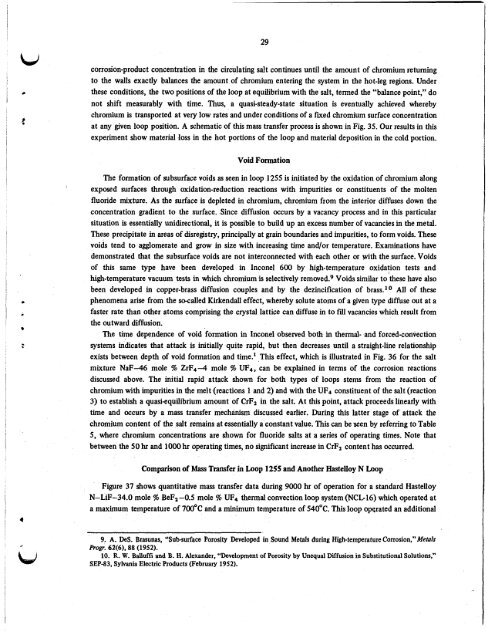Evaluation of hastelloy N alloys after nine years exposure to both a ...
Evaluation of hastelloy N alloys after nine years exposure to both a ...
Evaluation of hastelloy N alloys after nine years exposure to both a ...
Create successful ePaper yourself
Turn your PDF publications into a flip-book with our unique Google optimized e-Paper software.
LJ<br />
L<br />
f<br />
29<br />
corrosion-product concentration in the circulating salt continues until the amount <strong>of</strong> chromium returning<br />
<strong>to</strong> the walls exactly balances the amount <strong>of</strong> chromium entering the system in the hot-leg regions. Under<br />
these conditions, the two positions <strong>of</strong> the loop at equilibrium with the salt, termed the “balance point,” do<br />
not shift measurably with time. Thus, a quasi-steady-state situation is eventually achieved whereby<br />
chromium is transported at very low rates and under conditions <strong>of</strong> a fmed chromium surface concentration<br />
at any given loop position. A schematic <strong>of</strong> this mass transfer process is shown in Fig. 35. Our results in this<br />
experiment show material loss in the hot portions <strong>of</strong> the loop and material deposition in the cold portion.<br />
Void Formation<br />
The formation <strong>of</strong> subsurface voids as seen in loop 1255 is initiated by the oxidation <strong>of</strong> chromium along<br />
exposed surfaces through oxidation-reduction reactions with impurities or constituents <strong>of</strong> the molten<br />
fluoride mixture. As the surface is depleted in chromium, chromium from the interior diffuses down the<br />
concentration gradient <strong>to</strong> the surface. Since diffusion occurs by a vacancy process and in this particular<br />
situation is essentially unidirectional, it is possible <strong>to</strong> build up an excess number <strong>of</strong> vacancies in the metal.<br />
These precipitate in areas <strong>of</strong> disregistry, principally at grain boundaries and impurities, <strong>to</strong> form voids. These<br />
voids tend <strong>to</strong> agglomerate and grow in size with increasing time and/or temperature. Examinations have<br />
demonstrated that the subsurface voids are not interconnected with each other or with the surface. Voids<br />
<strong>of</strong> this same type have been developed in Inconel 600 by high-temperature oxidation tests and<br />
high-temperature vacuum tests in which chromium is selectively rem~ved.~ Voids similar <strong>to</strong>‘these have also<br />
been developed in copper-brass diffusion couples and by the dezincification <strong>of</strong> brass.l0 All <strong>of</strong> these<br />
phenomena arise from the so-called Kirkendall effect, whereby solute a<strong>to</strong>ms <strong>of</strong> a given type diffuse out at a<br />
faster rate than other a<strong>to</strong>ms comprising the crystal lattice can diffuse in <strong>to</strong> fdl vacancies which result from<br />
the outward diffusion.<br />
The time dependence <strong>of</strong> void formation in Inconel observed <strong>both</strong> in thermal- and forced-convection<br />
systems indicates that attack is initially quite rapid, but then decreases until a straight-line relationship<br />
exists between depth <strong>of</strong> void formation and time.’ This effect, which is illustrated in Fig. 36 for the salt<br />
mixture NaF-46 mole % ZrF4-4 mole % UF4, can be explained in terms <strong>of</strong> the corrosion reactions<br />
discussed above. The initial rapid attack shown for <strong>both</strong> types <strong>of</strong> loops stems from the reaction <strong>of</strong><br />
chromium with impurities in the melt (reactions 1 and 2) and with the UF4 constituent <strong>of</strong> the salt (reaction<br />
3) <strong>to</strong> establish a quasi-equilibrium amount <strong>of</strong> CrF2 in the salt. At this point, attack proceeds linearly with<br />
time and occurs by a mass transfer mechanism discussed earlier. During this latter stage <strong>of</strong> attack the<br />
chromium content <strong>of</strong> the salt remains at essentially a constant value. This can be seen by referring <strong>to</strong> Table<br />
5, where chromium concentrations are shown for fluoride salts at a series <strong>of</strong> operating times. Note that<br />
between the SO hr and 1000 hr operating times, no significant increase in CrF2 content has occurred.<br />
Comparison <strong>of</strong> Mass Transfer in Loop 1255 and Another Hastelloy N Loop<br />
Figure 37 shows quantitative mass transfer data during 9000 hr <strong>of</strong> operation for a standard Hastelloy<br />
N-LiF-34.0 mole % BeFz-0.5 mole % UF., thermal convection loop system (NCL16) which operated at<br />
a maximum temperature <strong>of</strong> 70O0C and a minimum temperature <strong>of</strong> 540°C. This loop operated an additional<br />
9. A. Des. Brasunas, “Sub-surface Porosity Developed in Sound Metals during High-temperature Corrosion,” Metals<br />
Prog. 62(6), 88 (1952).<br />
10. R. W. Balluffi and B. H. Alexander, “Development <strong>of</strong> Porosity by Unequal Diffusion in Substitutional Solutions,”<br />
SEP-83, Sylvania Electric Products (February 1952).



![Review of Molten Salt Reactor Physics Calculations [Disc 2]](https://img.yumpu.com/21979492/1/190x247/review-of-molten-salt-reactor-physics-calculations-disc-2.jpg?quality=85)













